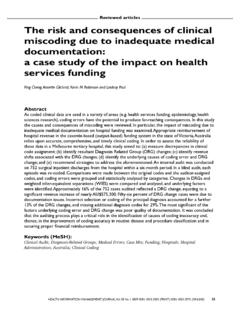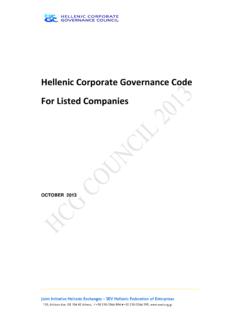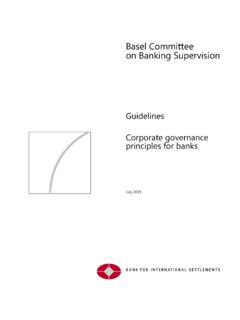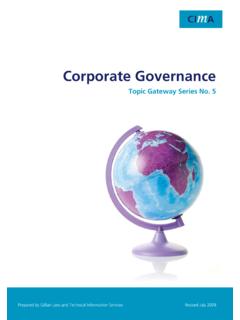Transcription of Corporate Governance Toolkit for small and medium ...
1 Corporate Governance Toolkitfor small and medium enterprises:2nd Edition April 2005 Corporate Governance Toolkit ForwardThis series of information sheets is part of the CPA Australia program to advance financial reporting and Governance issues. It is sponsored by CPA Australia and authored by PricewaterhouseCoopers. CPA Australia ( ) is a major international accounting body with membership of more than 105,000 finance, accounting and business professionals around the globe. PricewaterhouseCoopers ( ) provides industry-focused assurance, tax, legal and advisory services for public and private clients worldwide. It assists clients to understand and implement good practice Corporate Governance principles and effectively integrate these into a framework meeting the client s needs and circumstances. The Corporate Governance Toolkit focuses on the practical application of Governance principles for small and medium enterprises and provides straightforward guidance.
2 Corporate Governance is constantly evolving to reflect the current Corporate , economic and legal environment. The information sheets which make up the Corporate Governance Toolkit provide generic guidance on Corporate Governance practices. There will be specific legal and regulatory requirements in each country which are relevant to individual organisations. To be effective, Corporate Governance practices need to be tailored to the particular needs, objectives and risk management structure of an organisation. No person should undertake or refrain from any action based on the information in this publication without seeking advice from their professional advisers. 2nd EDITION . Dated: April 2005 Corporate Governance is consistently evolving to reflect the current Corporate , economic and legal environment.
3 This information sheet provides generic guidance on Corporate Governance practices. There will be specific legal and regulatory requirements in each country which are relevant to individual organisations. To be effective, Corporate Governance practices need to be tailored to the particular needs, objectives and risk management structure of an organisation. No person should undertake or refrain from any action based on the information in this publication without seeking advice from their professional advisers. Copyright PricewaterhouseCoopers. All rights reserved Corporate Governance Toolkit ContentsForward1 Overview What is Corporate Governance ? Governance in an SME 2 In the boardroom Roles and responsibilities Directors duties Role of the chairman Board composition Board committees Charters Effective board meetings Boardroom conduct Board papers Minutes and action items Access to papers and advice 3 The board and the organisation Corporate values.
4 Ethics and codes of conduct Stakeholder relations Conducting an AGM Director education Succession planning Remuneration issues The audit committee 4 The relationship with auditors Selecting an external auditor The external auditor relationship Evaluating the external auditor Internal audit Overseeing the work of the internal audit function5 Performance assessment Performance assessment Board performance assessment Audit committee performance assessment 6 Oversight and supervision Delegations of authority Risk management The internal control framework 7 Practical guidance Effective budgeting Compliance Early warning signs of failure 8 Companies in Australia Board awareness ASX Corporate Governance Council: Principles and recommendations ASX Corporate Governance Council: Disclosures CLERP 9 disclosures Corporate Governance Toolkit 1: Overview What is Corporate Governance ?
5 Corporate Governance is a topic that has received growing attention in the public in recent years as policy makers and others become more aware of the contribution good Corporate Governance makes to financial market stability and economic growth. Corporate Governance is all about controlling your business and so is relevant, and indeed vital, for all organisations, whatever size or concept of Corporate Governance has proved difficult to define precisely, because it covers a large number of concepts and economic relationships that affect many people. The OECD has the following working definition of Corporate Governance : " Corporate Governance is the system by which business corporations are directed and controlled. The Corporate Governance structure specifies the distribution of rights and responsibilities among different participants in the corporation, such as the board, managers, shareholders and other stakeholders, and spells out the rules and procedures for making decisions on Corporate affairs.
6 By doing this, it also provides the structure through which the company objectives are set, and the means of attaining those objectives and monitoring performance." This is summed up in a quote from Corporate Practices and Conduct, 3rd edition1: The essence of any system of good Corporate Governance is to allow the board and management the freedom to drive their organisation forward but to exercise that freedom within a framework of effective accountability .1 Bosch Committee, Corporate Practices and Conduct, Third Edition, 1995, Australia The basic principles of effective Corporate Governance are threefold: Based on these principles, organisations and markets around the world have considered the appropriate mechanisms for their markets. For example, the UK started their Corporate Governance regime with the Cadbury Code of Practice published by the London Stock Exchange in 1992, which has been regularly updated, most recently as a new Combined Code in 2004.
7 Other examples include: the OECD, which publishes guidelines on Corporate Governance South Africa, where the comprehensive King Report on Corporate Governance was issued in 2002 Australia, where the Australian Stock Exchange Corporate Governance Council issued a set of principles of good Corporate Governance in 2003 Hong Kong, where the Hong Kong Society of Accountants has produced a number of relevant publications, including a updated basic framework of principles in 2004 the US, where various stock exchanges, such as the NY Stock Exchange, have set out specific requirements in relation to Governance mechanisms. Transparency Are the board telling us what isgoing on?Accountability Is the board taking responsibility?Good, effective Governance Corporate Control Is the board doing the right thing?
8 2nd EDITION . Dated: April 2005 Corporate Governance is consistently evolving to reflect the current Corporate , economic and legal environment. This information sheet provides generic guidance on Corporate Governance practices. There will be specific legal and regulatory requirements in each country which are relevant to individual organisations. To be effective, Corporate Governance practices need to be tailored to the particular needs, objectives and risk management structure of an organisation. No person should undertake or refrain from any action based on the information in this publication without seeking advice from their professional advisers. Copyright PricewaterhouseCoopers. All rights reserved The Australian recommendations of the ASX Corporate Governance Council, for example, translate to the basic principles as follows: The King Report from South Africa expands on the three basic principles to separate out characteristics within these principles2, as a basis for its framework, and other country specific requirements may concentrate on specific parts rather then the principles overall.
9 However, whatever regime is in place, when considering Corporate Governance issues, and specifically recommendations in relation to systems or mechanisms, it is useful to concentrate on the overall purpose of good Governance : to assist organisations to achieve their strategic objectives. 2 The King Report characteristics are set out in information sheet Governance in an the elements translate into mechanisms Safeguard integrity in financial reporting Make timely and balanced disclosure Respect the rights of shareholders Encourage enhanced performance Recognised and manage risk Remunerate fairly and responsibly Recognise the legitimate interests of stakeholders Promote ethical and responsible decision making Lay solid foundations for management and oversight Structure the board to add valueIs the board doing the right thing?
10 Is the board taking responsibility? Creating an environment to take risk Are they telling us what is going on? Clarifying the role of board and management Meeting information needs of investment communities Corporate Governance Toolkit 1: Overview Governance in an SME 2nd EDITION. Dated: April 2005 Corporate Governance is consistently evolving to reflect the current Corporate , economic and legal environment. This information sheet provides generic guidance on Corporate Governance practices. There will be specific legal and regulatory requirements in each country which are relevant to individual organisations. To be effective, Corporate Governance practices need to be tailored to the particular needs, objectives and risk management structure of an organisation. No person should undertake or refrain from any action based on the information in this publication without seeking advice from their professional advisers.










